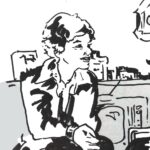Policy and Practice Exhibits
De-institutionalization was a big idea of policy makers and professionals of the 1950s and 1960s. What lay behind this shift in mental health policy, and who were the professional actors in the process? Explore the following exhibits in our Policy and Practice section.
The Last Asylums
 Transporting the asylum into the deinstitutionalization era, this exhibit walks you through the dissolving walls of thirteen large Canadian psychiatric hospitals. These institutions once represented the hopes of psychiatry and the state to rehabilitate citizens deemed mentally ill, serving as patient residences, staff workplaces, and sites of medical experimentation. Visit The Last Asylums.
Transporting the asylum into the deinstitutionalization era, this exhibit walks you through the dissolving walls of thirteen large Canadian psychiatric hospitals. These institutions once represented the hopes of psychiatry and the state to rehabilitate citizens deemed mentally ill, serving as patient residences, staff workplaces, and sites of medical experimentation. Visit The Last Asylums.
Educating Indian Head
 Draw your own conclusions about Canada’s first experiment in mental health education. Can you reduce stigma by teaching people about mental illness? In 1951 researchers Elaine and John Cumming traveled to Indian Head, Saskatchewan, to test that idea. In a turn of unparalleled irony, the townsfolk grew hostile towards the Cummings and the mayor told them to leave. Visit Educating Indian Head.
Draw your own conclusions about Canada’s first experiment in mental health education. Can you reduce stigma by teaching people about mental illness? In 1951 researchers Elaine and John Cumming traveled to Indian Head, Saskatchewan, to test that idea. In a turn of unparalleled irony, the townsfolk grew hostile towards the Cummings and the mayor told them to leave. Visit Educating Indian Head.
Between Two Worlds
 Read what the practitioners have to say about their struggles to redefine themselves in a deinstitutionalized world. As the big psychiatric institutions closed in the 1960s and 1970s, many of the staff found work in community mental health programs. Historian Chris Dooley presents the stories of front-line prairie mental health workers and his own reflections. Visit Between Two Worlds.
Read what the practitioners have to say about their struggles to redefine themselves in a deinstitutionalized world. As the big psychiatric institutions closed in the 1960s and 1970s, many of the staff found work in community mental health programs. Historian Chris Dooley presents the stories of front-line prairie mental health workers and his own reflections. Visit Between Two Worlds.
